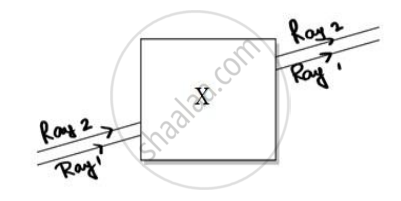Advertisements
Advertisements
प्रश्न
The absolute refractive indices of two media 'A' and 'B' are 2.0 and 1.5 respectively. If the speed of light in medium 'B' is 2 × 108 m/s, calculate the speed of light in:
(i) vacuum,
(ii) medium 'A'.
उत्तर
Absolute refractive index of medium 'A', `mu_A=2.0`
Absolute refractive index of medium 'B', `mu_B=1.5`
(i) For medium 'B',
`1.5=c/((2xx10^8))`
`rArrc=2xx1.5xx10^8`
`rArrc=3xx10^8`
Speed of light in vacuum is ⇒v=cμA
⇒v=cμA.
(ii) For medium 'A',
`mu_A=c/v`
`rArrv=c/mu_A`
`rArrv=(3xx10^8)/2`
`rArrv=1.5xx10^8`
Thus, speed of light in medium 'A' is 1.5 x 108 m s-1.
APPEARS IN
संबंधित प्रश्न
A ray of light travelling in air enters obliquely into water. Does the light ray bend towards the normal or away from the normal? Why?
Find out, from Table, the medium having highest optical density. Also find the medium with lowest optical density.
| Material medium | Refractive index | Material medium | Refractive index |
| Air | 1.0003 | Canada Balsam | 1.53 |
| Ice | 1.31 | – | – |
| Water | 1.33 | Rock salt | 1.54 |
| Alcohol | 1.36 | – | – |
| Kerosene | 1.44 | Carbon disulphide | 1.63 |
| Fused quartz | 1.46 | Dense flint glass | 1.65 |
| Turpentine oil | 1.47 | Ruby | 1.71 |
| Benzene | 1.50 | Sapphire | 1.77 |
| Crown glass | 1.52 | Diamond | .42 |
Which of the following diagrams shows the ray of light refracted correctly?
Fill in the following blank with a suitable word:
When a ray of light goes from air into a clear material, you see the ray bend. How much the ray bends is determined by the ............... of the material.
The speed of light in air is 3 × 108 m/s. In medium X its speed is 2 × 108 m/s and in medium Y the speed of light is 2.5 × 108 m/s Calculate:
(a) air nx
(b) air nY
(c) x nY
The refractive index of water with respect to air is `4/3`. The refractive index of air with respect to water will be:
(a) 1.75
(b) 0.50
(c) 0.75
(d) 0.25
Define the refractive index of a medium.
Noor, a young student, was trying to demonstrate some properties of light in her Science project work. She kept ‘X’ inside the box (as shown in the figure) and with the help of a laser pointer made light rays pass through the holes on one side of the box. She had a small butter-paper screen to see the spots of light being cast as they emerged.

She measured the angles of incidence for both the rays on the left side of the box to be 48.60. She knew the refractive index of the material ‘X’ inside the box was 1.5. What will be the approximate value of angle of refraction?
(use the value: sin 48.6° ≈ 0.75)
| The ability of medium to refract light is expressed in terms of its optical density. Optical density has a definite connotation. It is not the same as mass density. On comparing two media, the one with the large refractive index is optically denser medium than the other. The other medium with a lower refractive index is optically rarer. Also the speed of light through a given medium is inversely proportional to its optical density. |
- Determine the speed of light in diamond if the refractive index of diamond with respect to vacuum is 2.42. Speed of light in vacuum is 3 × 108 m/s.
- Refractive indices of glass, water and carbon disulphide are 1.5, 1.33 and 1.62 respectively. If a ray of light is incident in these media at the same angle (say θ), then write the increasing order of the angle of refraction in these media.
- (A) The speed of light in glass is 2 × 108 m/s and is water is 2.25 × 108 m/s.
(a) Which one of the two optically denser and why?
(b) A ray of light is incident normally at the water glass interface when it enters a thick glass container filled with water. What will happen to the path of the ray after entering the glass? Give reason.
OR
(B) The absolute refractive indices of glass and water are 4/3 and 3/2, respectively. If the speed of light in glass is 2 × 108 m/s, calculate the speed of light in (i) vacuum (ii) water.
- Explain why the refractive index of any material with respect to air is always greater 1.
- In the figure below a light ray travels from air into the semi-circular plastic block. Give a reason why the ray does not deviate at the semi-circular boundary of the plastic block.

- Complete the ray diagram of the above scenario when the light ray comes out of the plastic block from the top flat end.
